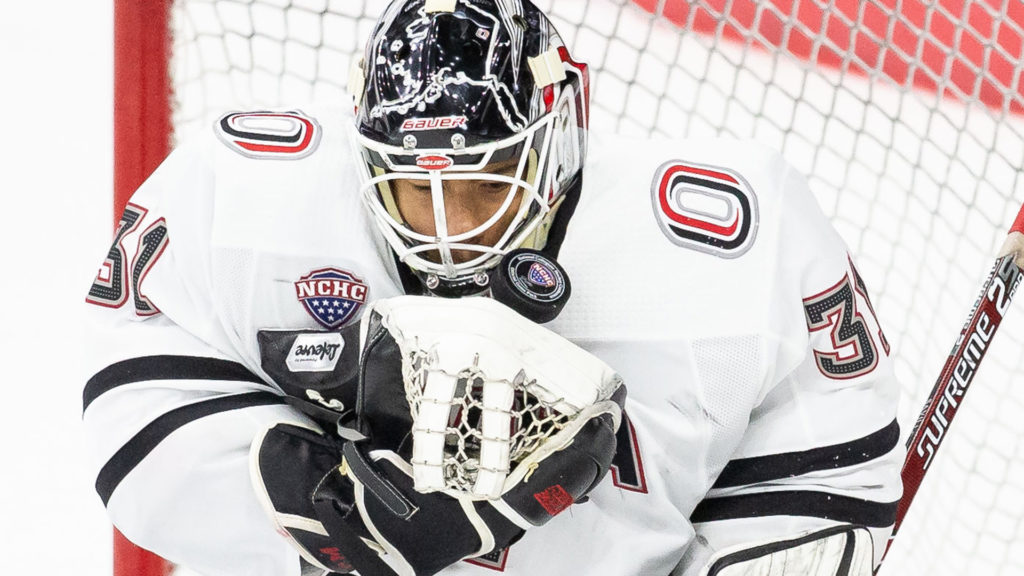
Each week during the season, we look at the big events and big games around Division I men’s college hockey in Tuesday Morning Quarterback.
Jim: Well, Dan, we’re one month into the season for most teams, Ivies excluded. But everyone is now underway with their full schedule, so it’s time for me to ask a question that typically comes about at this time: Are any teams beginning to panic?
Certainly, you can’t win the national championship in October, but if your team plays poorly enough, it can put itself in a hole that gets a little too large from which to crawl.
Right now, there are only two teams that really worry me. One is Wisconsin, which began the year 11th in the USCHO.com preseason poll. At 3-5-0, the Badgers feel like they’re more in rebuilding mode after losing Dylan Holloway and Cole Caufield to the NHL. But Friday’s win at Michigan gives me a little bit of hope.
The other team that worried me is Boston University. Picked 10th nationally in the preseason poll, the Terriers have dropped games to Sacred Heart, Merrimack and then this weekend were swept by UMass Lowell scoring just one goal in the two-game series.
Maybe both of these team have reason for concern. But do you think either team is pressing the panic button? And are there others for which you’re feeling a sense of concern?
Dan: If you had given me both Wisconsin and BU before the season and told me to choose one more likely to struggle early in the season, I likely would have picked the Badgers after they lost their four best scorers following last season. It was kind of an expectedly-onrushing storm for them to lose Caufield and Holloway in the same offseason as both Linus Weissbach and Ty Pelton-Byce from last season, but to lose four 30-point scorers and a Hobey Baker Award winner is going to be tough for any team.
Throw in the loss of a 50-game goaltender in Robbie Beydoun, and I at least expected some growing pains from them this year. That the split happened this weekend against Michigan is a good thing, and we’ll learn a lot more about this team when it hosts Minnesota with some momentum.
BU, on the other hand, is a surprising team for me, and I’m not really sure about what’s happened. Nearly every top skater from last year’s team returned short of David Farrance, who signed with Nashville following his senior year, but the Terriers haven’t been able to find a spark from their 10-win season a year ago.
Part of me wonders if the January start and 16-game season shrouded the team in mystery last year to the degree that I couldn’t take too many number seriously – Jay O’Brien led the team with 16 points and eight goals last year – but bringing everyone back from a young roster with that many NHL draft picks should have taken an immediate jump.
Instead, the split with UConn preceded a split with Sacred Heart, and another split with Merrimack came before this weekend’s sweep against UMass-Lowell. I don’t know if that’s enough for a panic button, but it’s certainly enough for me to harbor some serious concerns.
Now, there are two ways of looking at this: we can either sit back and declare both teams dead, or we can remember that games in March are a long way from games in October and November. I’m hesitant to do the first one, but I think slow starts in general are usually a cause for concern because losses now inevitably haunt a team when March rolls around. That also leads back to the second point that games now are the most critical ones during the year. A team can’t win a championship in October, but it can certainly lose one before the year gets going.
Given what’s happened, I think there are some clear angles leading to both teams. I expected Wisconsin to struggle out of the gate with a brutal schedule, and the losses to St. Cloud and Michigan Tech surrounding wins against Army validated my thoughts. That the team split with Michigan is encouraging, in my mind, but I think we’ll learn more against Minnesota.
As for BU, there is some inconsistency. I don’t mind a loss to UConn or Sacred Heart or even Merrimack, especially since two of those teams are in-league, but I don’t like losing to all three of them. As for UMass Lowell, it’s important to remember that whenever UMass, Northeastern and UMass Lowell climb the Hockey East standings, someone has to drop. At least in October, it looks like it might be BU.
The last piece, and I think this is something we see in other sports, is the element of a preseason ranking holding too much water weight. We’ll never see end-of-season rankings that look anything like a preseason ranking, and we always come back to the same powerhouses in the preseason poll. For that reason, maybe there’s too much love handed to certain teams, even as the poll can be accused of recency bias, which is something we all have a habit of doing during the course of a year.
With that tone, let’s turn things around. We talked about two teams that have struggled out of the gate, but what are two teams with hot starts that you think are real, at least for now?
Jim: So you want two teams that have opened my eyes. I don’t think that is too difficult, but I’ll start out with Omaha.
After dropping an OT decision to Lake Superior to begin the season, Omaha is 7-0-0. They’ve faced Maine, Alaska and LIU since winning the second game against the Lakers and will open league play with Miami twice this weekend. Is there a caveat to this Mavericks team? Possibly. Omaha plays its first 10 teams in the confines of home. That’s 10 games without having to board a bus or a plane, without having to face a hostile environment. Let’s see where this team lands once NCHC play begins, but I like what I’ve seen so far.
The other is Penn State. The Nittany Lions had a bit of an easy schedule to being the season – two against LIU, two against Canisius (losing one) and two against Niagara – all six of these games at home. But they faced the true litmus test on Saturday when they knocked off North Dakota in Nashville. The announced attendance for the game was a little less than 14,000, but watching video, it seemed like at least 13,000 of those fans were clad in green, white and black, supporting North Dakota. That was quite a hostile environment for the Nittany Lions to earn that win.
While on this topic, it was announced that next year’s destination game for North Dakota (technically known as the U.S. Hockey Hall of Fame Game) is in Las Vegas against Arizona State. I’d expect a sellout crowd at T-Mobile Arena given the destination and the two teams that are playing. North Dakota’s fan base will go to the moon to watch their team play while Arizona State has the strongest alumni base in college hockey.
That leads me to this question: Do you think there is any other college hockey team, aside from North Dakota, that would attract anywhere near a sellout crowd in a destination game?
Dan: Alright so this is a loaded question, but I like where we’re headed with it because I think certain teams could sell out the stands in a destination game under the right circumstances.
For example, let’s step into our Deloreans and go back to 2010 when Boston College played Boston University at Fenway Park the week after the Winter Classic. That was a sellout in both teams’ backyard at a time when the outdoor hockey game was a novelty, and I think people were buoyed by the novelty of playing the biggest college hockey rivalry in New England (and arguably the country) at arguably the most famous venue in sports. At the time, Fenway was a destination, even though it was about a half mile from the BU campus.
But that’s not what you meant. What you were actually asking was about which teams would entice their fans to board a flight and go somewhere, and truthfully, I’m not sure if anyone can do what North Dakota did or is doing. I feel like the biggest fanbases belong to the Beanpot schools, but I can’t picture their groups heading down to Nashville with the same ferocity as the North Dakota fans. I likewise don’t see it happening to any of the ECAC schools, though 10,000 fans did follow Harvard and Yale to Madison Square Garden two years ago, and I’ll always believe New York City is a destination, though, again, that’s not what you meant.
The fact that I have to try and poke loopholes in the argument should tell you exactly what you need to know about the argument. North Dakota sold out that game in Vegas against Minnesota a few years ago. They helped put 13,000 fans at TD Ameritrade Park for a WCHA game against Omaha, and they put 11,000-plus fans at MSG for a game against BC, which is more than what Harvard-Yale had. I’m surprised we didn’t find a way to send them to Belfast, though I guess travel would have been substantially longer with connecting flights.
This got me thinking, though. Vegas has more than proven itself as a hockey market and will host the Frozen Four in 2026. The city itself offers more than a few reasons why it’s a great place for a large-scale event, but if you look at the next Frozen Fours, there’s been a concerted move back to the proven hockey areas. This year’s in Boston, next year’s in Tampa, the year after in Minnesota and the year after that in St. Louis before we move to Vegas.
Where are some hockey markets that you’d like to see a game? Vegas is atop that list, and it’s not even close for me, but I’d be interested to see how things would fare in both California and Texas when you consider the number of hockey teams playing in both states. California, in particular, intrigues me since it’s one of the fastest-growing hockey states among youth players for USA Hockey.
Jim: And before we upset too many fans, we should also include Red Hot Hockey, the every-other-year matchup between Boston University and Cornell in New York. That draws well, but put the game in Nashville and I don’t see the same attendance draw.
As for markets to watch games, I’m fortunate to have watched games in two of the destinations on your list – California and Las Vegas. I, in fact, saw them in one trip two years ago when Harvard and Arizona State played in Irvine, Calif., and then T-Mobile Arena hosted the Ice Vegas Invitational. But when you talk crowds, neither were head turning.
The Arizona State-Harvard games, a two-game series, drew well into a small 2,000-ish seat rink. The Vegas tournament was mostly empty in a 17,000-plus seat venue. But put North Dakota in either area, boom!
I agree that somewhere in Texas would be a great destination. Dallas is the obvious choice, but I’d love to see an event in Austin, where the H-E-B Arena, home of the AHL’s Texas Stars, boasts a capacity around 8,000.
I guess there is another desire of mine to watch an American college hockey game played north of the border, somewhere in Canada. It would be wonderful to see a college game in Montreal or Toronto, or more likely, a game featuring North Dakota in Winnipeg, a quick three-hour ride from Grand Forks.
I have heard the conversations before about possibly soliciting a Canadian city to bid for a Frozen Four. And part of me thinks it would be fun and interesting. I just don’t know if U.S. college fans would travel. Do you agree?
Dan: There’s a part of me that thinks Montreal and Toronto are the perfect locations for a Frozen Four, and Vancouver, from what I’ve been told, is an incredible trip and a gorgeous city. I feel like Calgary is Canada’s answer to Dallas, too, with the whole Stampede/rodeo vibe and the oil industry playing a huge role in the city’s growth.
I fear, though, that the American college game won’t have the same appeal to the Canadian audience. I know junior hockey does well, specifically thinking about the OHL and the attendance numbers from a couple of years ago, but I’m admittedly not sure if the Frozen Four will succeed north of the border.
Throw in the requirements for fans to cross the border, which we have to assume will be easier as COVID subsides into the past, and it’s either going to be an amazing atmosphere of dedicated Canadian fans, Canadian families and Canadian friends blending with American fans who all have passports, or we’re going to see a limited crowd in a half-empty arena because people don’t want to cross the border and the Frozen Four only has limited appeal compared to the Memorial Cup or the World Juniors.
Then again, it’s also outside the box, and I love that about sports. Take the United 2026 bid for the World Cup in soccer, which I believe was the result of wanting to return to North America while not rehashing a return to the United States. It mixed Canada and Mexico into the bid in a way that combined the three biggest powers, and given the rivalry between Mexico and the USA, it was a great way to capitalize and blend the two schools on the unique continent.
Moving the Frozen Four to Canada would, in a parallel, blend the Canadian junior and hockey culture into the American game and would hypothetically break barriers between two countries with a growing, great hockey rivalry.
The short, short version: it’s a crazy idea, but it beats returning to the scene of some empty arenas that we’ve seen in the past. So let’s give it a short and see what happens.


